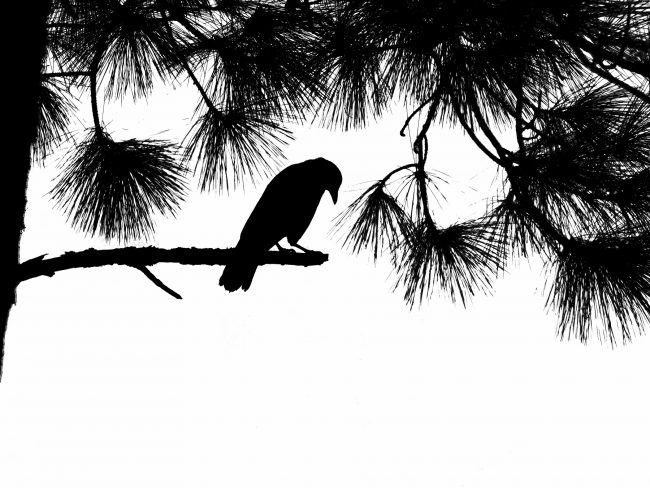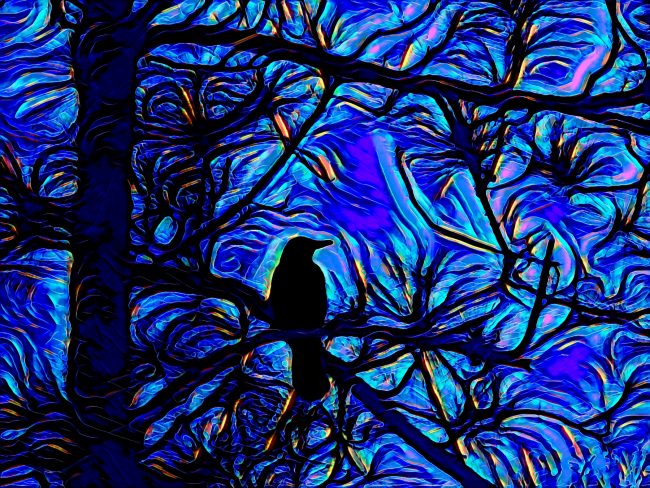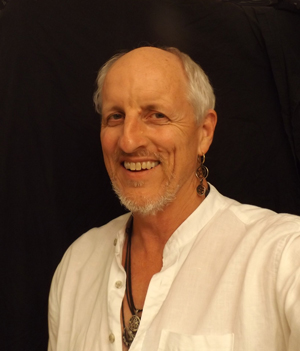
A Palm Coast artist’s trippy, photographic digital art of crows will be featured in “Mr. Crow Saves the Universe,” an exhibition May 1-24 in the Rose Room at Peabody Auditorium in Daytona Beach.
The exhibit will feature 20 prints on canvas by Rick de Yampert, a freelance writer, musician, artist and lecturer who also is the arts and culture writer for FlaglerLive. An opening reception will be held from 5:30-7:30 p.m. May 2 and will feature de Yampert performing on sitar and Native American flutes. He also will present a talk on his artistic process and the magical, mystical nature of crows.
His book “Crows and Ravens: Birds of Myth and Magic” will be published by Llewellyn in 2020.
“All of my Mr. Crow art springs from the 3,000 or so photos I’ve taken of these magical, mystical creatures in nature,” de Yampert says. “In this case nature is the backyard of my home in Palm Coast, which borders on woods and a natural-looking canal where I also have witnessed otters, deer, turtles, black racer snakes, red-shouldered hawks, alligators and many other creatures during my decade living here.
“I love ‘shape-shifting’ the crows of my photographs into phantasmagoric, trippy and magical landscapes,” he says. “I do that through a half-dozen digital processes, including a digital ‘paint’ program in which the mouse is used as various ‘brushes’ to apply colors and lines. However, I never alter the shapes of the crows themselves. The forms of the crows you see in my art – heads tilted this way or that, wings a-flutter, etc. – are as they were captured by my camera in nature.”

Crows and their cousins the ravens – both part of the family of birds known as corvids – feature prominently in the myths, legends and spiritualities of cultures around the world, including the ancient Celts, the Norse and Native American tribes.
“Crows are magical, sacred creatures to me and to many other people,” de Yampert says.
Previously de Yampert was the arts and entertainment writer at the Daytona Beach News-Journal, a daily newspaper, for 23 years. As a professional musician, he plays sitar, Native American flutes, djembe (African hand drum), guitar and Moyo drum (a type of steel tongue drum). He has performed at art festivals, cafes, yoga sessions and sacred events throughout Central Florida.
As a lecturer, de Yampert presents programs on various spiritual topics to Unitarian Universalist churches, Pagan gatherings and other organizations and events. His lectures are multi-media presentations that often feature musical performances, and explore such topics as shamanic drumming, the Hindu sacred sound known as Om, Taoism, agnosticism, and the role of crows in the world’s mythologies and folklore.
“Mr. Crow Saves the Universe,” an exhibition of photographic digital artworks on canvas by Rick de Yampert, will be presented May 1-24, 2019, in the Rose Room of Peabody Auditorium, 600 Auditorium Blvd., Daytona Beach. An opening reception will be held from 5:30-7:30 p.m. May 2 and will feature de Yampert performing on sitar and Native American flutes. He also will present a talk on his artistic process and the magical, mystical nature of crows. Admission is free. For more information, go online at rickdeyampert.com or mistercrowart.com, or call Rick de Yampert at 386-334-2752.
![]()
We asked Rick de Yampert to elaborate on the sacredness of crows and other characteristic lore. He wrote the following:
Who was the first human – or proto-human – to take notice of the peculiar ways of crows and ravens, part of the bird family known as corvids?

No doubt the ancients witnessed the special behavior of corvids — they could see it with their own eyes — and began to weave the birds into their stories, legends and myths.
A rich body of lore, mythology and recorded history surrounds crows and their cousins the ravens. In the Christian bible, Noah sent forth a raven from the ark before he sent a dove. The Qur’an tells the story of how Allah sent a raven to show Cain how to bury Abel. In ancient Jewish rabbinic lore, Adam and Eve are distraught over what to do with the body of the murdered Abel — it is only after they witness a raven burying one of its dead that Adam says, “I shall do as this raven.”
Two ravens, Hugin and Munin, serve as the world-traversing eyes and ears — some say the “spies” — of Odin, the Norse god of wisdom, war and death. The Morrigan, the ancient Irish goddess of destiny and death (who sometimes appears as a triple goddess), will often shape-shift into the form of a crow – a dire omen for any warrior who sees her in that guise before battle. The exploits of Raven – usually a trickster with supernatural abilities – and Crow are featured in many Native American tales that serve as wisdom teachings or as stories that explain how the world came to be the way it is.
Crows and ravens are omnivores, meaning they will eat almost anything, including carrion – that is, the dead bodies of animals, birds and even humans, especially the corpses on ancient battlefields. Thus in ancient Norse and Anglo-Saxon poetry, ravens came to be associated with battles. Folklorists and historians say the birds’ carrion-feeding was one aspect that fed the belief that the presence of crows or ravens is an ill omen, and even foretells death.
Scholars say the medieval Icelandic historian Snorri Sturluson, a Christian, faithfully recorded the old Norse myths in his 12th-century work now known as the Prose Edda. It is Snorri’s work where we read of the two ravens, Hugin and Munin (usually translated as “Thought” and “Memory”), who are Odin’s helpers.
The Prose Edda and another work, the anonymously penned Poetic Edda, tell of the Valkyries, female supernatural beings who help the Odin by deciding which warriors will live or die in battle. When Vikings died in battle, the Valkyries would ferry those slain warriors favored by Odin to Valhalla, where they will feast and prepare to fight by his side during the impending, climactic, cosmic battle of Ragnarok.
The ninth-century Norse skaldic (court-composed) poem “Hrafnsmál,” which translates as “Raven Song”) relates a conversation between a Valkyrie and a raven as they discuss the life and martial exploits of King Harald Fairhair.




























Vinnie says
I know the story of the Two Seagulls…..Gertrude and Heathcliff !
palmcoaster says
I understand that crows are one of the smartest birds. That shadowed profile of one perching in attention to a meal potential catch, speaks for itself. Typical crow demeanor.